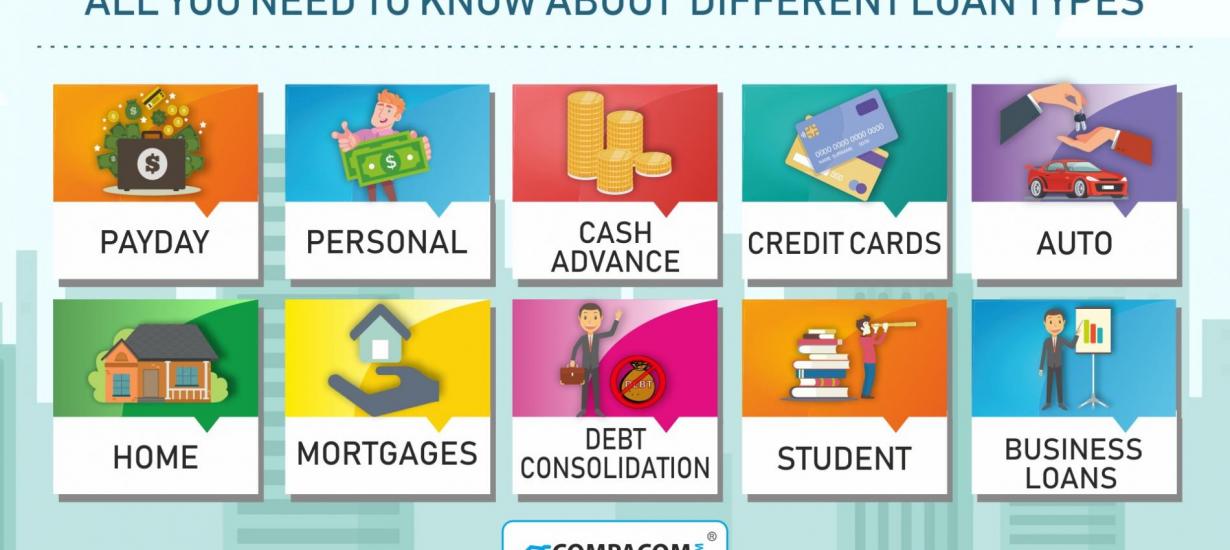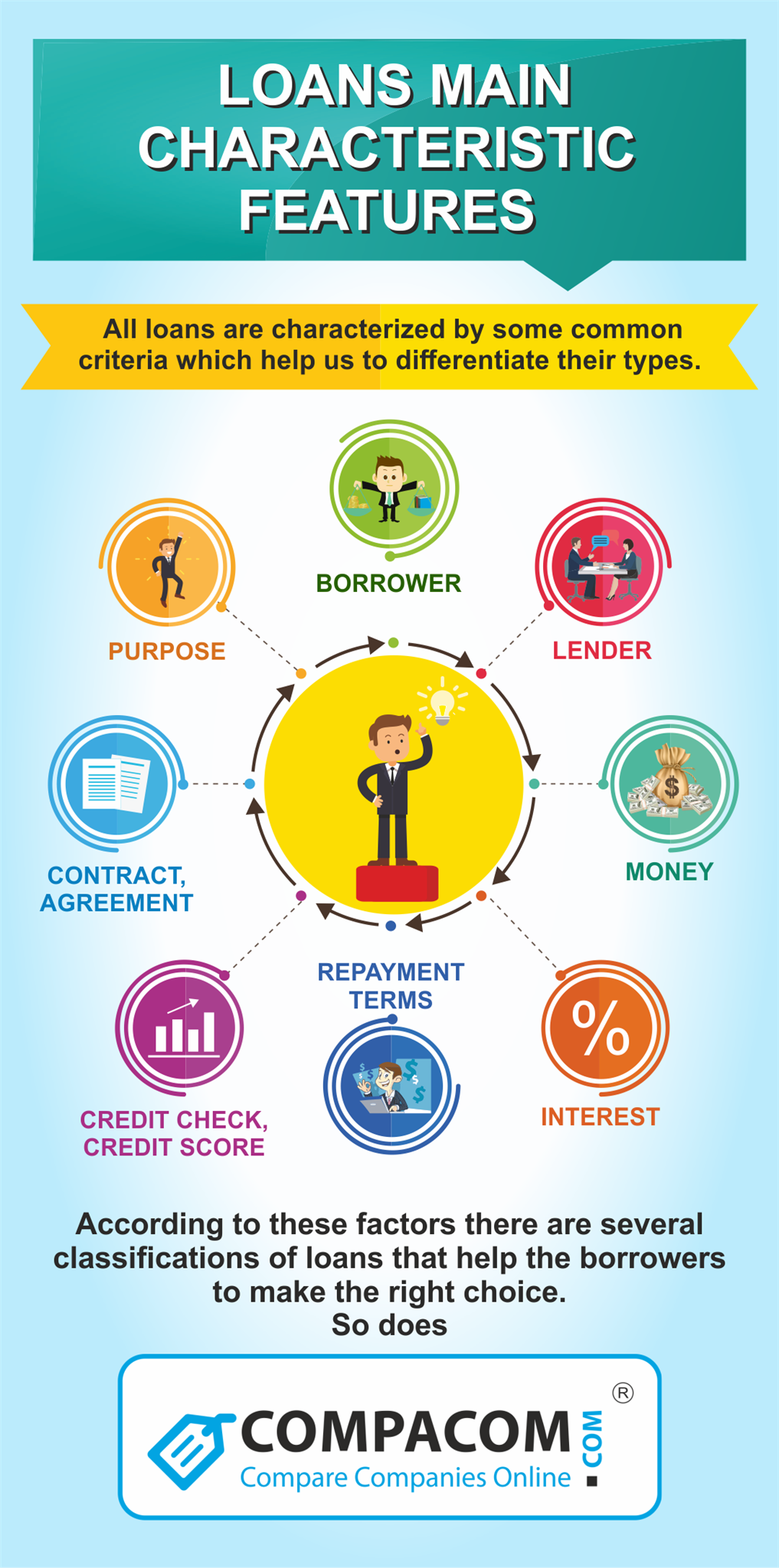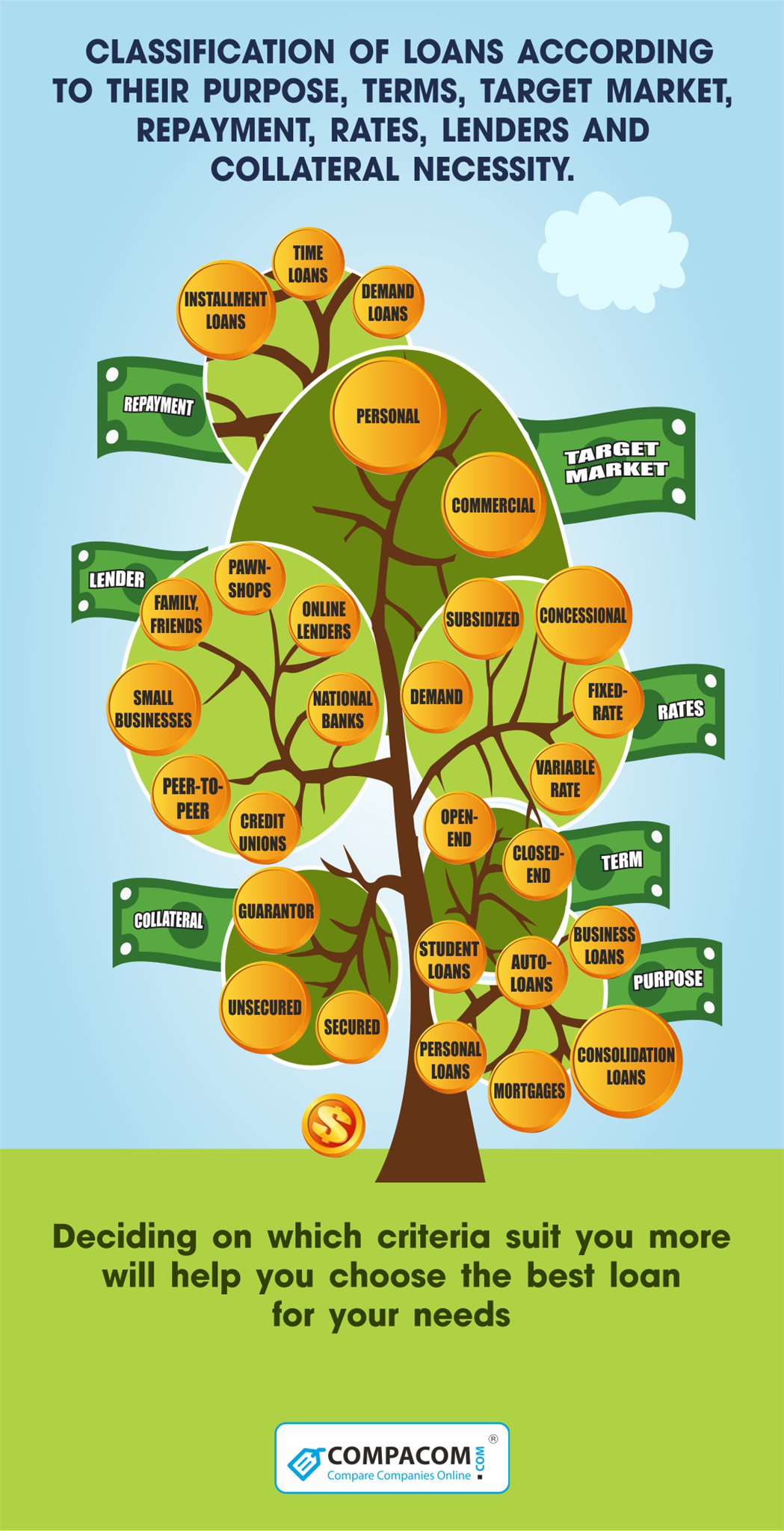Everybody may face some financial difficulties in life. There are different types of loans to meet any of people’s needs. All of them have different purposes and conditions. By the way, they vary according to the amount, terms, rates, fees and other factors. To choose the one that suits your situation you’d better do some research and find out what loan options you have, what are pros and cons of each and make a responsible decision before applying. Our article presents a thorough guide into the world of loans that will definitely help you to find yours.
Contents
Installment Loans. Cash time loans.
Personal Loans vs Loans for specific purpose.
Online loans. Banks. Credit unions.
Loan definition.
A loan is a written or oral agreement for a temporary transfer of a property (usually cash) from its owner (the lender) to a borrower who promises to return it according to the terms of the agreement, usually with interest for its use .
A credit is
- An agreement between a buyer and a seller in which the buyer receives the good or service in advance and makes payment later, often over time and usually with interest.
- The amount in a bank account or some other account 1.
The difference between these notions is a slight one. They may mean the same in certain context, but can differ in another situation. On the whole, the term “credit” is wider than “loan”. Loan is also a type of credit, while the later can also refer to the deposit made in your bank account. A loan is particularly lending term and means the act of borrowing while credit is more the ability to borrow. For example, if you have $1,000 credit, you can get some of this money when you need it. If you have $1,000 loan, you already own it today.
Loan types vary because each loan has a specific intended use. They can vary by length of time, by how interest rates are calculated, by when payments are due and by a number of other variables.
Ad
Different types of loans.
Loan repayment.
The two main categories of consumer credit according to the repayment term are open-end (revolving) and closed-end credit2.
|
Credit type |
Open-end |
Closed-end |
|
Examples |
|
|
|
Purpose |
Any personal needs: daily expenses, such as food, clothing, transportation and small home repairs |
Specific purpose: to buy a car, a house, etc. |
|
Interest charges |
Applied only if you don’t pay the monthly balance in full. 0 - 30%, 15% on average. |
Varies by lender and depends on the borrowers credit score |
|
Terms |
Not limited |
Specific term |
|
Repayment |
Repeatedly in some parts monthly but not in full. |
Regular (usually monthly) payments until it’s fully repaid. |
|
Credit score |
Hard but can be approved for bad credit score. |
Can be suitable for bad credit, but the lower the score the higher the rates are. |
Installment Loans. Demand Loans. Time Loans.
According to the way repayment is done there are:
- Demand loans, which are repaid on the demand of the lender.
- Installment loans, which are repaid in equal monthly payments.
- Time loans, which are paid back in lump sum on the expiration date.
Estimated Payment
$ 543.05
| Total Principal Paid: | $ 500.00 |
|---|---|
| Finance charge: | $ 43.05 |
| APR: | 375.93 % |
Payment Breakdown
Select the amount for the loan you want in order to get the principal, which is the basis that we use to calculate the interest and the total cost of the cash advance.
The number of days within that you will be ready to repay the loan. It’s used to count the total cost of cash advance by multiplying the days by the amount of interest.
To calculate the total cost of your loan, we take the minimal average APR legal in all States, which is 36%. This figure is only a representative, providing you with general information on how much the loan may cost. To find out a more accurate total, fill in the Annual Percentage Rate required by the lender you want to apply to.
It’s the money charged by the lender for doing all the necessary paper work, bank transactions, etc., connected with lending you the money.
General purpose loans vs loans for specific purpose.
People need money to meet the incredible number of various needs and luckily there are loans to suit any of them. According to the purpose the credit is taken economists and bankers differentiate the following loan types:
General purpose loans: without any designated purpose, lent for any of everyday personal expenses and needs:
- Personal loans
- Installment loans
- Payday loans
- Credit cards
- Cash advances
- Home equity loans
- Credit line
- Lombard loans
They can be used for any of the following: medical or dental services, car or home repair, debt consolidation, vacations, traveling, anniversaries, weddings, etc.
Specifiс purpose loans: lent only for a certain kind of expenses:
- Student loans: federal student loans and private student loans - are used to cover the cost of higher education.
- Mortgages - to buy homes.
- Auto-loans - to buy a vehicle.
- Business loans - to start or expand a business.
- Consolidated loans - to pay off outstanding debts.
Secured and unsecured loans.
Secured loans - A secured loan is money that you borrow secured against something that you own. If you don’t repay the loan, the lender has the right to take the asset you put up as security. It can be your:
- house (‘homeowner loans’ or ‘second mortgages’),
- car (‘logbook loans’),
- jewellery and gadgets (‘pawnbroker loan’).
The most common examples of secured loans are:
- Mortgage
- Auto loan
- Auto title or pawn loan
Unsecured loans - you don’t have to use anything as security for this type of loan (e.g. your house or car). The offer of a loan is based on the information held in your credit report, along with some personal details in your application (such as your income, which doesn’t appear on your credit report).
The examples of unsecured loans are:
- credit card debt
- personal loans
- bank overdrafts
- credit facilities or lines of credit
- corporate bonds (may be secured or unsecured)
- peer-to-peer lending
Guarantor loans - a good option for those with a low credit score. You need to ask someone else – the ‘guarantor’ – to agree to be responsible for paying the debt if you can’t. The guarantor will need to have a good credit history and will usually be a parent, another member of your family or your partner.
Online loans. Banks. Credit unions.
Loans can be applied for online or in-store or some other financial organization. For pros and cons of online vs in-store lending read our article. The places where people may look for extra money are:
- National banks (US Bank, Wells Fargo, Capital One)
- Credit unions
- Peer-to-peer loans
- Online lenders
- Retirement plans
- Private businesses
- Family and friends
- Pawn shops 3
Whichever place you choose take into account all pros and cons and compare all the possible options on COMPACOM.com to make the right choice.
TOP RATED COMPANIES
ONLINE COMPANIES
Loan rates.
According to the rates the loans can be:
- Fixed rates - all the rates and fees are fixed and stated in the agreement.
- Variable rates - rates can change meanwhile the loan is repaid depending on changing economic conditions.
- Demand loans are short-term loans that typically do not have fixed dates for repayment. Instead, demand loans carry a floating interest rate which varies according to the prime lending rate or other defined contract terms. Demand loans can be "called" for repayment by the lending institution at any time. Demand loans may be unsecured or secured.
- A subsidized loan is a loan on which the interest is reduced by an explicit or hidden subsidy. In the context of college loans in the United States, it refers to a loan on which no interest is accrued while a student remains enrolled in education6
- A concessional loan, sometimes called a "soft loan", is granted on terms substantially more generous than market loans either through below-market interest rates, by grace periods or a combination of both. Such loans may be made by foreign governments to developing countries or may be offered to employees of lending institutions as an employee benefit (sometimes called a perk) 4.
Ad
Personal loans vs business loans.
Loans can also be subcategorized according to whether the debtor is an individual person (consumer) or a business.
- Personal - mortgage loans, car loans, home equity lines of credit, credit cards, installment loans and payday loans
- Commercial- small business loans, commercial mortgages and corporate bonds.
Loan terms.
SHORT-TERM LOANS - less than 1 year.
- A special commitment loan - a single-purpose loan to cover unexpected cash shortages.
- Trade credit - is extended by a vendor who allows the purchaser up to three months to settle a bill.
- A seasonal line of credit of less than one year may be used to finance inventory purchases or production. The successful sale of inventory repays the line of credit.
- A permanent working capital loan - financing for a business when cash flow from earnings does not coincide with the timing or volume of expenditures.
INTERMEDIATE-TERM LOANS - 1 -5 years, used to buy furniture, fixtures, vehicles, plant and office equipment, autos, boats, and home repairs and remodeling.
LONG-TERM LOANS - 10 - 40 years, for example mortgages 5.
Taking into account all of the above mentioned characteristics we’ve made up a table. Here you can see the most popular Lon types and their main features. It may help you get all the necessary information about each type of credit and choose the one that suits your needs.
The table of loans and their characteristics.
|
Type of loan |
Amounts |
Terms |
Rates |
Purpose |
Collateral or guarantor |
Repayment |
Pros |
Cons |
Alternatives |
|
Payday loans |
$100 - $1,000 |
14 – 30 days |
Fixed: 300% - 750% APR |
any |
None, unsecured |
In a lump sum |
Fast Easy Available for bad credit No credit check |
Expensive |
Installment loans Personal loans Peer-to-peer lending Cash advances |
|
Installment loans |
$1,000 - $5,000 |
6 - 60 months |
6.63% - 225% |
Any |
None, unsecured |
In regular equal installments |
Fast Easy No credit check in most cases |
Rather high APR Expensive |
Payday loans Personal loans |
|
Auto Title loans |
25% to 50% of your car’s value |
30 days |
300% APR and up |
buying a vehicle or some other personal needs |
Your vehicle is a collateral |
In a lump sum |
Fast Easy No credit check in most cases |
Expensive You can lose your vehicle if you default a loan |
Personal loans Auto loans
|
|
Auto loans |
$5,000 - $100,000 |
6 - 7 years |
1.99% - 24.9% |
Buying a vehicle |
A vehicle is used as a collateral |
In regular payments |
Available for bad credit. Soft credit check possible. Legal in all the states. Opportunity to refinance your loan.
|
Some lenders only work with a network of dealerships. Others won’t lend money to buy cars from private sellers. Lenders may also exclude some makes of cars, certain models and types of vehicles, such as electric cars. |
Auto Title loans. Personal loans. |
|
Personal loans |
$5,000 - $25,000 |
6 - 60 days |
4.99% - 450% |
Any |
Secured or unsecured |
In regular equal installments |
Higher amounts and lower rates Unsecured in most cases Suits any needs Convenient repayment plan |
Not always suitable for bad credit Hard credit check may affect your score If your score is bad you may expect higher rates7
|
Installment loans Consolidated loans Line of credit |
|
Line of credit |
$5000 and more |
7.25% - 20% |
Variable |
Any, it’s reusable |
Secured or unsecured. |
You pay interest on the amount you use, not the entire credit limit. All the debt must be repaid by the end of the term8
|
Flexible Less expensive Higher amounts It’d reusable You repay the interest only on the amount you use |
Interest is variable, can increase A balloon payment at the end of the term (when you still have to pay all the principal) A lot of additional fees |
Personal loans Installment loans |
|
Cash advances |
Depends on the limit of your credit line |
Up to a month. |
5% of the amount withdrawn |
Any daily expenses |
Unsecured |
On the next payday in a lump amount. |
Available from any ATM. Available for bad credit. |
Expensive. |
Personal loan Borrowing from friends Overdrawing your checking account |
|
Credit cards |
Up to $50,000 |
Not limited |
13.99% to 22.99% |
any personal needs |
Unsecured |
Monthly payments |
Interest free grace period. Convenient for immediate spending. Balance transfer for debt consolidation. |
Higher interest rates. Only requires a minimum repayment each statement period. |
Personal loan. |
|
Student loans9
|
$39,40010
|
10-30 years11
|
Fixed: 5.05% - 7.6%12
|
education |
No collateral, cosigner needed |
In regular monthly payments |
Let you get good education Can be spent on room and board as well Can help you build credit |
Can be expensive Default can damage your score |
Family help Choosing to live with parents instead of campus |
|
Mortgages |
The home purchase price minus down payment |
10 - 40 years |
4.125% - 5.016% APR14
|
Buying a house |
Your property is a collateral |
In monthly payments |
Homeownership. Potential tax breaks. It’s a good investment.
|
Expensive. A risk of foreclosure and home loss. Payment changes. |
Borrow from a retirement account. Borrow from parents. Get a co-signer. Rent. Save.13
|
|
Home-equity loans |
depends on what your home is worth, 90% - 95% of your combined loan to value ratio. |
5 - 15 years |
Fixed rates, 5.56% - 5.79% |
One big lump sum of money for a big purchase |
Secured by the value of your equity in your home |
In monthly payments |
Fixed rates. Predictable payments. Lower rates than consumer loans. Good to consolidate debts. A big sum of money at once.
|
You risk your home. If the equity value declines, you may go underwater. Expensive closing costs.
|
Mortgage. Personal loan. Home-equity line of credit |
|
Home-equity line of credit |
depends on what your home is worth |
Up to 10 years |
Variable rates, 5.72% - 6.31% |
Extra cash for long-term projects like home improvement |
Secured by the value of your equity in your home |
You may pay only interest during the loan term and when it ends pay the principal. |
An adjustable interest rate. Draw money as you need it. Pay interest only on the amount you draw.
|
Variable rates. You risk your home.
|
Personal loan. Home-equity loan. Second mortgage. |
|
Small business loans |
$30K - $350K |
10 - 20 years |
7.25% - 975% |
To open or develop your business. |
Unsecured, or pledged by a plant, equipment or vehicle. |
In monthly payments |
You don’t have to dilute your equity, you can sell it. You can accelerate your growth. You can overcome cash flow changes. |
Interest rates can be high. MIN 680 credit score. At least $100K in revenues. Borrowing can reduce your options.
|
Personal line of credit. Start-up loans. |
|
Consolidation loans |
$2,000 - $10,000 |
30 - 60 months |
13.9% - 27.2% |
To consolidate all your debts. |
Unsecured, or secured, or co-signer loans. |
In equal monthly payments. |
Lower rates. Available for bad credit. Fewer payments. Can help you [ay off the debt sooner.
|
You may get into more debt. You need a good counseling to benefit from it. |
Balance transfer card. Home equity loan. Some equity line of credit. Personal loan.
|
Ad




You are about to post a question on compacom.com:
Any comments or reviews made on this website are only individual opinions of the readers and followers of the website. The website and its authors team are not responsible, nor will be held liable, for anything anyone says or writes in the comments. Further, the author is not liable for its’ readers’ statements nor the laws which they may break in the USA or their state through their comments’ content, implication, and intent.